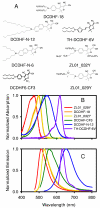Diffusion of lipid-like single-molecule fluorophores in the cell membrane
- PMID: 16610918
- PMCID: PMC1702323
- DOI: 10.1021/jp0574145
Diffusion of lipid-like single-molecule fluorophores in the cell membrane
Abstract
The dicyanomethylenedihydrofuran (DCDHF) class of single-molecule fluorophores contains an amine donor and a dicyanomethylenedihydrofuran acceptor linked by a conjugated unit (benzene, naphthalene, or styrene). Molecules in this class have a number of useful properties in addition to those usually required for single-molecule studies (such as high fluorescence quantum yield and photostability), including second-order optical nonlinearity, large ground-state dipole moment, and sensitivity to local environment. Moreover, most DCDHF molecules have amphiphilic structures, with a polar dicyanomethylenedihydrofuran headgroup and nonpolar hydrocarbon tails on the amine or furan ring, and can be used as fluorescent lipid analogues for live cell imaging. Here we demonstrate that individual molecules of several different DCDHF lipid analogues can be observed diffusing in the plasma membrane of Chinese hamster ovary cells. The photophysical and diffusive behaviors of the DCDHF lipid analogues in membranes are described and are found to be competitive with the well-known lipid probe N-(6-tetramethylrhodaminethiocarbamoyl)-1,2-dihexadecanoyl-sn-glycero-3-phosphoethanolamine.
Figures





Similar articles
-
Photophysical properties of acene DCDHF fluorophores: long-wavelength single-molecule emitters designed for cellular imaging.J Phys Chem A. 2007 Sep 20;111(37):8934-41. doi: 10.1021/jp0712598. Epub 2007 Aug 24. J Phys Chem A. 2007. PMID: 17718454 Free PMC article.
-
DCDHF fluorophores for single-molecule imaging in cells.Chemphyschem. 2009 Jan 12;10(1):55-65. doi: 10.1002/cphc.200800581. Chemphyschem. 2009. PMID: 19025732 Free PMC article. Review.
-
A photoactivatable push-pull fluorophore for single-molecule imaging in live cells.J Am Chem Soc. 2008 Jul 23;130(29):9204-5. doi: 10.1021/ja802883k. Epub 2008 Jun 24. J Am Chem Soc. 2008. PMID: 18572940 Free PMC article.
-
Alkoxy-styryl DCDHF fluorophores.Phys Chem Chem Phys. 2010 Jul 28;12(28):7768-71. doi: 10.1039/c003752b. Epub 2010 May 17. Phys Chem Chem Phys. 2010. PMID: 20473439
-
Nonlinear optical chromophores as nanoscale emitters for single-molecule spectroscopy.Acc Chem Res. 2005 Jul;38(7):549-56. doi: 10.1021/ar0401294. Acc Chem Res. 2005. PMID: 16028889 Review.
Cited by
-
Enzymatic activation of nitro-aryl fluorogens in live bacterial cells for enzymatic turnover-activated localization microscopy†.Chem Sci. 2013;42:220-225. doi: 10.1039/C2SC21074F. Chem Sci. 2013. PMID: 23894694 Free PMC article.
-
Model lipid bilayer with facile diffusion of lipids and integral membrane proteins.Langmuir. 2010 Jul 6;26(13):11157-64. doi: 10.1021/la101046r. Langmuir. 2010. PMID: 20459075 Free PMC article.
-
Bulk and single-molecule characterization of an improved molecular beacon utilizing H-dimer excitonic behavior.J Phys Chem B. 2007 Jul 19;111(28):7929-31. doi: 10.1021/jp073310d. Epub 2007 Jun 21. J Phys Chem B. 2007. PMID: 17583944 Free PMC article.
-
Single-molecule motions of oligoarginine transporter conjugates on the plasma membrane of Chinese hamster ovary cells.J Am Chem Soc. 2008 Jul 23;130(29):9364-70. doi: 10.1021/ja710798b. Epub 2008 Jun 26. J Am Chem Soc. 2008. PMID: 18578528 Free PMC article.
-
Improved synthesis of DCDHF fluorophores with maleimide functional groups.Tetrahedron Lett. 2006 Oct 2;47(40):7213-7217. doi: 10.1016/j.tetlet.2006.07.142. Tetrahedron Lett. 2006. PMID: 18584068 Free PMC article.
References
-
- Brown DA, London E. Ann. Rev. Cell & Dev. Bio. 1998;14:111–136. - PubMed
-
- Anderson RGW, Jacobson K. Science. 2002;296:1821–1825. - PubMed
-
- Edidin M. Annu. Rev. Biophys. Biomol. Struct. 2003;32:257–283. - PubMed
-
- Lagerholm BC, Weinreb GE, Jacobson K, Thompson NL. Annual Review of Physical Chemistry. 2005;56:309–336. - PubMed
-
- Schmidt T, Schutz GJ, Baumgartner W, Gruber HJ, Schindler H. J. Phys. Chem. 1995;99:17662–17668.
Publication types
MeSH terms
Substances
Grants and funding
LinkOut - more resources
Full Text Sources

